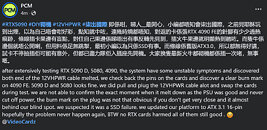T0@st
News Editor
- Joined
- Mar 7, 2023
- Messages
- 3,063 (3.88/day)
- Location
- South East, UK
| System Name | The TPU Typewriter |
|---|---|
| Processor | AMD Ryzen 5 5600 (non-X) |
| Motherboard | GIGABYTE B550M DS3H Micro ATX |
| Cooling | DeepCool AS500 |
| Memory | Kingston Fury Renegade RGB 32 GB (2 x 16 GB) DDR4-3600 CL16 |
| Video Card(s) | PowerColor Radeon RX 7800 XT 16 GB Hellhound OC |
| Storage | Samsung 980 Pro 1 TB M.2-2280 PCIe 4.0 X4 NVME SSD |
| Display(s) | Lenovo Legion Y27q-20 27" QHD IPS monitor |
| Case | GameMax Spark M-ATX (re-badged Jonsbo D30) |
| Audio Device(s) | FiiO K7 Desktop DAC/Amp + Philips Fidelio X3 headphones, or ARTTI T10 Planar IEMs |
| Power Supply | ADATA XPG CORE Reactor 650 W 80+ Gold ATX |
| Mouse | Roccat Kone Pro Air |
| Keyboard | Cooler Master MasterKeys Pro L |
| Software | Windows 10 64-bit Home Edition |
Late last month, NVIDIA claimed that 16-pin power connector issues were a thing of the past. The controversial 12VHPWR connection standard has fueled many online debates—prompting investigations from several prominent press outlets. Following NVIDIA's latest "safety" declaration—likely by coincidence—PCM Hong Kong reported another melting incident, affecting two cables and a power supply unit. The publication's hardware reviewer was recently engaged in the "full-load" testing of GeForce RTX 5090D and RTX 5080 graphics cards. Last week's evaluation session was interrupted by notable test system instabilities—upon downing tools, the PCM staffer discovered that their 1200 W PSU had given up the ghost. Additionally, two 16-pin cables had melted at both ends—initial detective work pointed to a GeForce RTX 4090 sample card being the main culprit.
VideoCardz and UNIKO's Hardware kept close tabs on PCM's next steps—online interactions, over the past weekend, spurred a re-evaluation of circumstances. According to PCM's latest update, they noticed burn marks on the GeForce RTX 4090 test unit—the two GeForce RTX-50-series cards did not exhibit any physical damage. Post-analysis, the reviewer now suspects that an SSD failure could be the root cause. They were happy to report that all involved RTX cards have survived, and that their test platform has been re-equipped with 12V-2x6 cables. An amended VideoCardz article proposes that everything came down to a simple human error.


View at TechPowerUp Main Site | Source
VideoCardz and UNIKO's Hardware kept close tabs on PCM's next steps—online interactions, over the past weekend, spurred a re-evaluation of circumstances. According to PCM's latest update, they noticed burn marks on the GeForce RTX 4090 test unit—the two GeForce RTX-50-series cards did not exhibit any physical damage. Post-analysis, the reviewer now suspects that an SSD failure could be the root cause. They were happy to report that all involved RTX cards have survived, and that their test platform has been re-equipped with 12V-2x6 cables. An amended VideoCardz article proposes that everything came down to a simple human error.


View at TechPowerUp Main Site | Source









